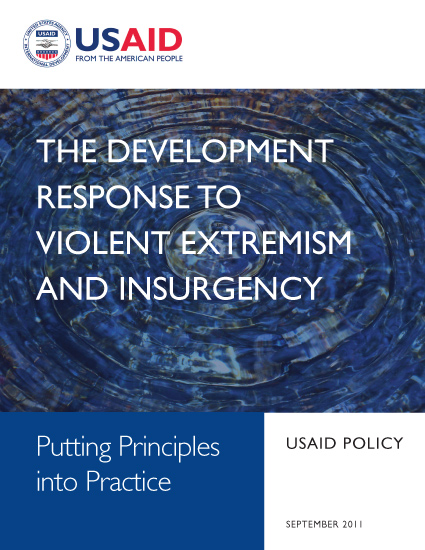"We will take action against threats to our security and our allies, while building an architecture of counterterrorism cooperation. We will increase efforts to lift up those who counter extremist ideologies and who seek to resolve sectarian conflict. And we will expand our programs to support entrepreneurship and civil society, education and youth -- because, ultimately, these investments are the best antidote to violence." – President Obama, September 2014 address to the U.N. General Assembly
PROGRAM PRINCIPLES
The U.S. Agency for International Development (USAID) has long recognized the critical role of development in addressing social, economic, governance and other factors that can drive violent extremism or radicalization of individuals and communities. Countering Violent Extremism (CVE) is central to achieving the Agency’s mission to end extreme poverty and promote resilient, democratic societies while advancing our security and prosperity.
In 2011, the agency issued “The Development Response to Violent Extremism and Insurgency” policy, which recognizes the importance of identifying and addressing drivers of extremism, and notes that much of U.S. foreign assistance goes to countries in the midst of, or trying to prevent, conflict or state failure. USAID currently manages programs that specifically address drivers of violent extremism in Africa, the Middle East and Asia.
Based on rigorous, locally-informed risk assessments and analysis, USAID’s approach has concentrated on youth empowerment, social and economic inclusion, media and messaging, improved local governance and in some cases reconciliation and conflict mitigation. Activities are tailored to meet the specific threat levels, political environments and material needs of each community. Our CVE efforts often target distinct populations, for example at-risk young men, and increasingly recognize the unique role of women in promoting peace and security.
USAID has invested significant resources to monitor and evaluate counter violent extremism programming, gathering both quantitative and qualitative data, and are using the lessons learned from these programs to drive effective approaches to CVE.
SELECTED USAID-MANAGED CVE PROGRAMMING
Cross-Regional
- Trans-Sahara Counter-Terrorism Partnership: Along with the Department of State and Department of Defense, USAID is a founding member of the Trans-Sahara Counter-Terrorism Partnership, created in 2005. This multi-country interagency effort aims to counter violent extremism in the Sahel and Maghreb regions through building partner capacity and cooperation in prevention and interdiction efforts.
Africa
- Regional Violent Risk Assessments: Field-based analysis planned in critical areas of Africa to examine region-specific risk and drivers of violent extremism.
- Communities and CVE: Two-day trainings developed by the internationally recognized Hedayah curriculum on countering violent extremism.
- Regional Peace for Development: This program operates in multiple African countries and uses a community-led approach to focus on youth empowerment, education, media, and good governance.
- CVE Knowledge Management and Learning: USAID Africa missions and partners, including host governments, are working together to identify and share the latest research on CVE issues. This effort includes workshops, web-based training and other links between key African and international partners in the field of CVE.
Middle East and North Africa
- Regional analysis: A range of analytical products including assessments of risk of violent extremism across the region and trends analysis, as well as studies on governance and women and their interaction with violent extremism.
- Maghreb-Sahel CVE Capacity Building: This program will help communities and governments to develop and implement strategies to counter violent extremism. It is designed to counter efforts by violent extremists and to help reduce the flow of foreign terrorist fighters.








Comment
Make a general inquiry or suggest an improvement.